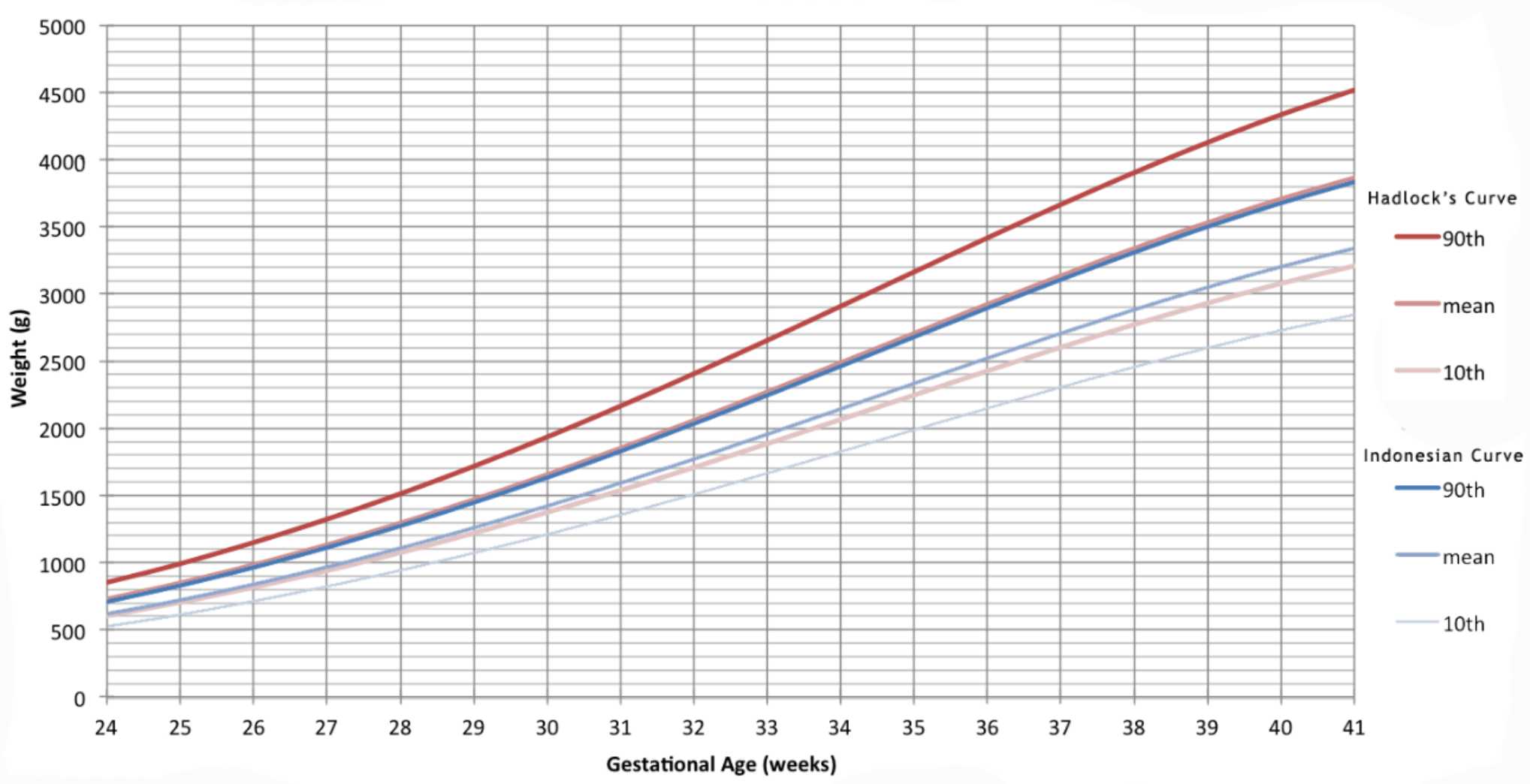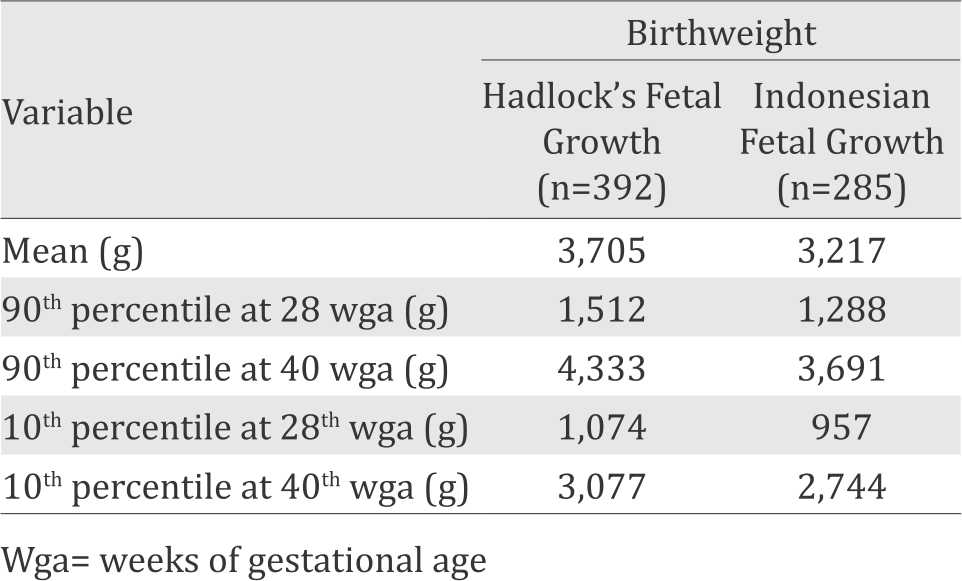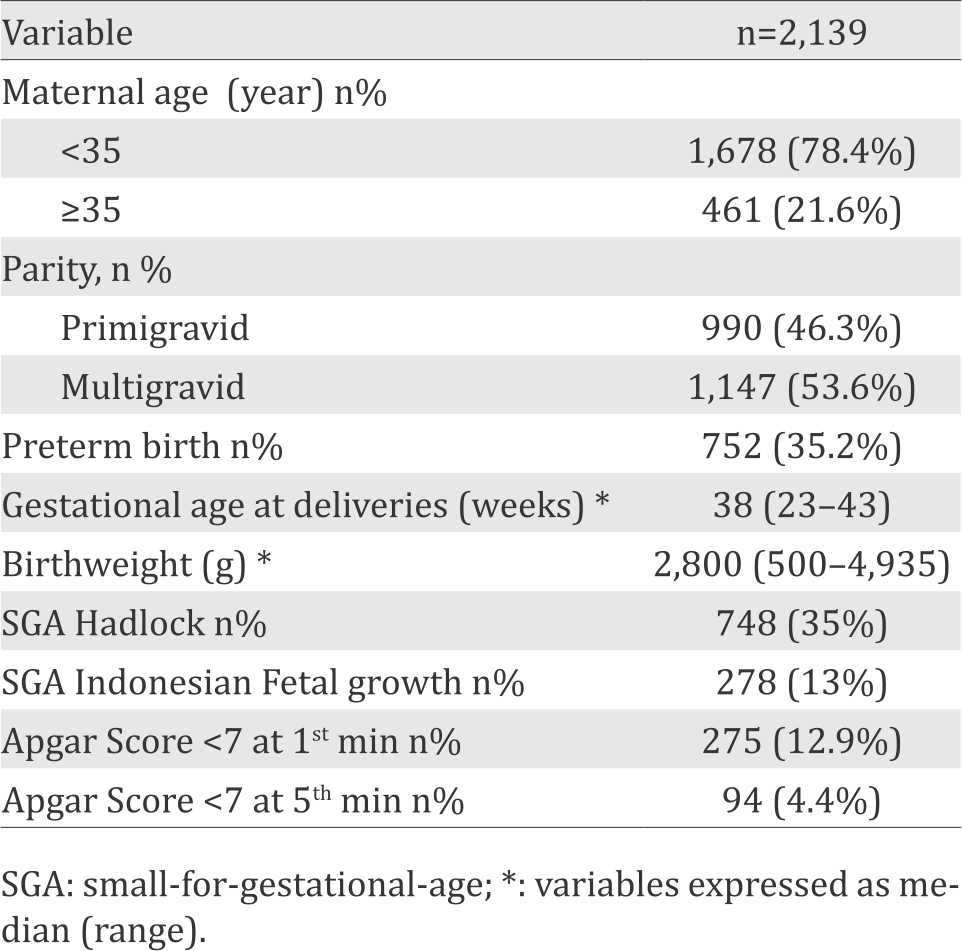
Section Abstract Introduction Methods Results Discussion Conflict of Interest Acknowledgment References
Clinical Research
Indonesian local fetal-weight standard: a better predictive ability for low Apgar score of small-for-gestational age neonates
pISSN: 0853-1773 • eISSN: 2252-8083
http://dx.doi.org/10.13181/mji.v25i4.1301 Med J Indones. 2016;25:228–33
Received: October 30, 2015
Accepted: September 04, 2016
Author affiliation:
1 Department of Obstetrics and Gynecology, Faculty of Medicine Universitas Indonesia, Cipto Mangunkusumo Hospital, Jakarta, Indonesa
2 Ministry of Education-Shanghai Key Laboratory of Children’s Environmental Health, Xinhua Hospital, Shanghai, China
Corresponding author:
Adly N.A. Fattah
E-mail: adlynanda@yahoo.com
Background
Accurate assessment of fetal growth is one of crucial components of antenatal care. A generic reference for fetal-weight and birthweight percentiles that can be easily adapted to local populations have been developed by Mikolajczyk and colleagues. This study aimed to validate our own local percentile standard by evaluating the odds ratio (OR) of low 1st and 5th minute Apgar score for small-forgestational age (SGA) versus those not SGA.
Methods
We used the generic reference tools for fetal-weight and birthweight percentiles developed by Mikolajczyk and colleagues to create our own local standard and then defined the SGA neonates. For validation, we used the database of singleton live deliveries (2,139 birth) during January 1st to December 31st 2013 in Cipto Mangunkusumo Hospital, Jakarta, Indonesia. We compared our reference with that of Hadlock and colleagues. For every reference, the OR of Apgar score <7 at 1st and 5th minutes for infants who were SGA versus those not estimated with bivariate and multivariate analyses.
Results
SGA found in 35% (748/2,139) and 13% (278/2,139) of neonates using the definition derived from Indonesian standard and Hadlock’s. OR of Apgar score <7 at 1st and 5th minutes were 3.45 (95% CI=2.56–4.65) and 3.05 (95% CI=1.92–4.83) for the Indonesian local fetalweight standard compared with respectively 2.14 (95% CI=1.65–2.76) and 1.83 (95% CI=1.21–2.77) for Hadlock and collegues’ reference.
Conclusion
Indonesian local fetal-weight standard has a better ability to predict low 1st and 5th minutes Apgar scores of SGA neonates than has the Hadlock and collegues’ reference.
Keywords
Apgar, small-for-gestational-age, standard, weight
Accurate assessment of fetal growth is one of crucial components of antenatal care,1 because intrauterine growth restriction (IUGR) could lead to the increased rate of perinatal mortality and morbidity.2 However, defining normal or abnormal fetal growth has become a great challenge in clinical research.3 Many studies have been conducted to find the best method to assess fetal growth.4 They are widely ranging methods from a simpleinexpensive fundal height measurement5 to the Doppler velocimetry and biomarkers work-up.3
In 2014, the International fetal growth standards for the clinical interpretation was issued. It was derived from women who were at low risk of IUGR in eight countries (Brazil, Italy, Oman, United Kingdom, United States, China, India, and Kenya).6 However, there was contrary statement that the use of customized or individualized fetal weight charts, with adjustment for maternal and fetal factors, have a better accuracy in predicting fetal weight compared to non-customized fetal-weight reference.7,8 Dutch already constructed their own reference standard for birthweight by parity, sex, and ethnic background, seperately.9 United States also have their own customized standard to assess the fetal growth and birthweight among their population by adjusting physiological coefficients (maternal height, weight, parity, ethnic origin, and sex of the baby), positive (diabetic mothers) and negative effects (smoking, history of preterm delivery, and hypertensive diseases) on birthweight.10 These standards were created as the consequences of statement that optimal neonatal outcome is achieved at different birth weights in different populations.4
It was internationally accepted that customized standards for fetal growth and birth weight improve the accuracy to detect IUGR by better distinction between physiological and pathological smallness.2,7 Ideal diagnosis of IUGR is complex because it should involve the growth potential of the fetus, current fetal size, fetal and placental health, and, if available, fetal growth velocity.3 Miller et al11 stated that normal fetal growth is affected by the genetically predetermined growth potential and later controlled by maternal, fetal, placental, and external factors11.
Mikolajczyk et al12 created generic reference for fetal-weight and birthweight percentiles that can be easily adapted to local populations. It has a better ability to predict adverse perinatal outcomes than the non-customized fetal-weight reference, and is simpler to use than the individualized reference without loss of predictive ability. They created a weight percentiles calculator that allow us to obtain weight percentile standards for our own local population by inserting the mean birthweight at 40 weeks of our population into the formula.12
In this present study, we aimed to develop our own local percentile standard of fetal birthweight using the generic reference tool developed by Mikolajczyk et al.12 We applied the correlation between small-for-gestational age and low 5th minute Apgar score to test the predictive ability of our fetal weight standard. It will be compared with the previous birthweight percentile developed by Hadlock et al13 that commonly used in our practical setting.
METHODS
The generic reference tool developed by Mikolajczyk et al12 was first downloaded in a form of excel (.xls) file. The original article was downloaded in order to analyze the method used in the development of the generic reference of the fetal weight chart. They made the weight reference easily adjustable according to the mean birthweight at 40 weeks of gestation for any local population after considering the fetal-weight reference developed by Hadlock et al13 and the notion of proportionality proposed by Gardosi et al.14 Optimum growth equation proposed by Hadlock et al13 was used to create a generic global reference.
Fetal weight (g) = exp(0.578 + 0.332 × GA – 0.00354 × GA2)
Hadlock et al13 performed ultrasound examination between 10 and 41 weeks of gestation of 392 pregnant women of the European Continental Ancestry Group in the USA. The statistical variation of fetal weight in a given gestational week was also provided and resulted in a constant fraction of mean. Therefore, the fetal-weight percentiles of each gestational week were developed13.
Gardosi et al5 created the individualized reference by using the Hadlock et al13 formula. They transformed the formula into a proportionality function. Therefore, a percentage of the expected weight based on Hadlock’s formula could be derived from a given individual birth weight. They also adjusted it for ethnic group, parity, sex of the infant, and maternal height and weight.14 To determine the mean birthweight, we use at least 100 deliveries at 40 weeks (40+0 to 40+6) and with no risk factors for having smallfor-gestational age (SGA) infants. Therefore for this purpose, pregnancy complicated with preeclampsia, intrauterine growth restriction, known congenital anomalies, maternal systemic disease i.e heart failure, diabetes mellitus were excluded from the initial database.
For application and validation, we used data from our delivery database at Cipto Mangunkusumo Hospital, Jakarta, Indonesia. This database contains clinical information on all women who delivered their babies during 1st January to 31st December 2013. Gestational age was determined based on first trimester ultrasound examination, and if not available, last menstrual period. SGA was defined as below 10th percentile for completed week of gestational age based on the local percentile standards. The percentile of each neonates’ birthweight was obtained from Fetal/Birth Weight Percentiles Calculator developed by Mikolajczyk et al.12 Apgar scores at 1st and 5th minutes below 7 established by competent perinatology residents was considered as low.
Bivariate analysis was used to find the association between the low Apgar score with SGA defined by both of Indonesian local fetal weight standard and Hadlock’s Fetal weight standard. P<0.05 was considered as significant association. Statistical analyses were conducted using software IBM® SPSS® Statistics version 20 (Armonk, NY: IBM Corp).
RESULTS
Mean birthweight at 40 completed weeks of gestation were respectively 3,705 grams and 3,217 grams by Hadlock et al13 and by our local standard. Hadlock et al13 performed ultrasound measurements between 10 and 41 weeks of gestation among 392 pregnant women of the European Continental Ancestry Group living in the USA in order to create the optimum growth equation. We calculated the mean birthweight of 285 neonates born in during 2013 who were not at risk of having SGA. Therefore, preeclamptic deliveries, IUGR fetus, fetal with known congenital anomaly were excluded prior to the calculation.
We developed two growth percentile standards (Figure 1) using the generic reference tool and then defined the SGA from both standards (Table 1).

Figure 1. Indonesian and Hadlock’s13 Fetal Growth Chart
Table 1. Birthweight mean and percentiles on Hadlock’s standard13 and Indonesian fetal growth standard

The 10th percentile value of fetal weight at 28 wga were respectively 1,074 g and 957 g defined by Hadlock’s standard and by Indonesian fetal growth standard. At 40 wga, the 10th percentile value was respectively 3,077 g and 2,744 g defined by Hadlock’s standard13 and by Indonesian fetal growth standard (Table 2).
Table 2. Delivery characteristics of database used for validation of Hadlock’s and Indonesian fetal growth chart

We validated the definition of SGA using the delivery database of 2,139 deliveries during 1st January to 31st December 2013 in Cipto Mangunkusumo Hospital Jakarta, Indonesia. Table 2 shows the characteristics of women underwent delivery registered in our database. The median (range) of maternal age was 29 years (13–48). More than half of the population was multigravida (53.6%). The median (range) of birthwight was 2,800 (500–4,935) grams. SGA was diagnosed in 35% (748/2,139) of the population using the definition derived from Hadlock’s standard13. However it found in 13% (278/2,139) of neonates when defined by Indonesian fetal growth standard definition. Low Apgar scores were found respectively in 12.9% (275/2,149) and 4.4% (94/2,139) of neonates (Table 3).
Table 3. Odds ratio of Apgar score < 7 at 1st and 5th minutes for infants who were SGA versus those not estimated with bivariate and multivariate analysis

Low Apgar scores at both of 1st and 5th minutes were significantly associated with the SGA neonates defined by both standards (p>0.005). OR of Apgar scores lower than 7 at 1st and 5th minutes were respectively 3.45 (95% CI=2.56–4.65) and 3.05 (95% CI=1.92–4.83) for the Indonesian local fetal-weight standard compared with respectively 2.14 (95% CI=1.65–2.76) and 1.83 (95% CI=1.21–2.77) for Hadlock et al13 standard. After adjusted with maternal age, parity, and preterm delivery, the OR of low 1st minute AS was improved from 3.45 to 3.53 using the definition of SGA derived from Indonesian standard. However, using the Hadlock’s et al13 definition, the SGA was no longer associated with low 5th minute AS (p>0.05) after adjusting other variables (Table 3).
DISCUSSION
We showed that Indonesian local fetal-weight standard has a better ability to predict low 1st and 5th minutes Apgar scores of SGA neonates than has the Hadlock13 and collegues13 reference. The evidences that SGA neonates have an increased risk of low 1st and 5th minutes Apgar scores were irrespective of the standard used for definition. In our study, however, most of low Apgar scores were found in infants without SGA. Consequently, the predictive value of status of SGA for low Apgar score is very low.12 Low Apgar score was closely related to most cases of early neonatal mortality as well as low birth weight and prematurity.15 It also has a significant association with SGA neonates.12
Mikolajczyk et al12 have published a reliable generic reference for fetal-weight and birthweight percentiles that can be easily adapted to local populations. They compared the prediction ability for adverse perinatal outcomes of their non-customized fetalweight reference with the fully individualized reference developed by Gardosi et al.14 Adverse perinatal events include any of stillbirth, dead within or after 24 hours of birth, alive on 7th day postpartum but referred to a higher level or special care unit, or Apgar score lower than seven at five minutes. We studied Apgar scores <7 at both of 1st and 5th minutes as the adverse perinatal event because the data are available in every deliveries record therefore the probability of having missing data would be reduced.
Odds ratio of Apgar score <7 at 5th minute was 3.05 (95% CI=1.92–4.83) for the Indonesian local fetal-weight standard. It was similar with OR of adverse outcomes (stillbirth, dead within or after 24 hours of birth, alive on 7th day postpartum but referred to a higher level or special care unit, or Apgar score <7 at five minutes) for infants SGA versus those SGA age determined by the country-specific reference developed by Mikolajczyk and colleagues 2.87 (95% CI=2.73–3.01).12 In addition, our findings supported the evidence that the local standard derived from generic tool12 has a better ability to predict adverse perinatal outcomes than has the non-customized fetal-weight reference.
We used the generic reference tool due to its proven-applicability and flexibility. It was validated in a large multinational study that included various ethnic groups. We considered that such tool is very useful in low-resource settings, especially where longitudinal ultrasound studies needed to examine variation in fetal growth were difficult to be conducted. To our knowledge, this is the first study that validates the generic reference tool developed by Mikolajczyk et al12 in Indonesia. Also, deliveries occurred over a year period in a tertiary medical center, is unlikely to affect to the Apgar score. However it has several limitations. First, by using this generic reference tool which is developed using the method proposed by Gardosi et al,14 a similar fetal growth pattern was assumed for all ethnic groups. However, this assumption might not always be accurate. Our hospital is a tertiary national referral hospital that allows multiethnic patients to be managed. In addition, we considered that defining normal and abnormal fetal growth using the reference or standard is found to be problematic in both of research fields and clinical practice.3 Second, we found similarly high prevalence of SGA in both standards (35% and 13% respectively for Indonesian standards and Hadlock’s standard13) using the cut off of 10th percentile. In undernourished population the prevalence would probably different. Therefore, this study result should only be generalized to pregnant women who have adequate nutrition.
Finally, utilization of a generic reference for fetal weight and birthweight can be completed with the approach developed by Mikolajczyk et al.12 A definition of SGA was largely dependent on the study population, i.e ethnic origin and maternal nutritional status. Indonesian local fetal-weight standard produced lower prevalence of SGA than Hadlock’s.13 It also has a better ability to predict low 1st and 5th minutes Apgar scores of SGA neonates than has the Hadlock et al13 reference.
Conflicts of Interest
The authors affirm no conflict of interest in this study.
Acknowledgment
This paper is based upon previous research work of Jun Zhang from MOE and Shanghai Key Laboratory of Children’s Environmental Health, Xinhua Hospital, Shanghai, China.
REFERENCES
- Bloemenkamp KWM. Fetal growth. Int Congr Series. 2005;1279:295–301.
- Gardosi J. Fetal growth standards: individual and global perspectives. Lancet. 2011;377(9780):1812–4.
- Zhang J, Merialdi M, Platt LD, Kramer MS. Defining normal and abnormal fetal growth: promises and challenges. Am J Obstet Gynecol. 2010;202(6):522–8.
- Reeves S, Bernstein IM. Optimal growth modeling. Semin Perinatol. 2008;32(3):148–53.
- Morse K, Williams A, Gardosi J. Fetal growth screening by fundal height measurement. Best Pract Res Clin Obstet Gynaecol. 2009;23(6):809–18.
- Papageorghiou AT, Ohuma EO, Altman DG, Todros T, Cheikh Ismail L, Lambert A, et al. International standards for fetal growth based on serial ultrasound measurements: the Fetal Growth Longitudinal Study of the INTERGROWTH-21st Project. Lancet. 2014;384(9946):869–79.
- Gelbaya TA, Nardo LG. Customised fetal growth chart: a systematic review. J Obstet Gynaecol. 2005;25(5):445–50.
- Kiserud T, Johnsen SL. Biometric assessment. Best Pract Res Clin Obstet Gynaecol. 2009;23(6):819–31.
- Visser GH, Eilers PH, Elferink-Stinkens PM, Merkus HM, Wit JM. New Dutch reference curves for birthweight by gestational age. Early Hum Dev. 2009;85(12):737–44.
- Gardosi J, Francis A. A customized standard to assess fetal growth in a US population. Am J Obstet Gynecol. 2009;201(1):25e1–7.
- Miller J, Turan S, Baschat AA. Fetal growth restriction. Semin Perinatol. 2008;32:274–80.
- Mikolajczyk RT, Zhang J, Betran AP, Souza JP, Mori R, Gülmezoglu AM, et al. A global reference for fetal-weight and birthweight percentiles. Lancet. 2011;377(9780):1855–61.
- Hadlock FP, Harrist RB, Martinez-Poyer J. In utero analysis of fetal growth: a sonographic weight standard. Radiology. 1991;181(1):129–33.
- Gardosi J, Mongelli M, Wilcox M, Chang A. An adjustable fetal weight standard. Ultrasound Obstet Gynecol. 1995;6(3):168–74.
- Ersdal HL, Mduma E, Svensen E, Perlman J. Birth asphyxia: a major cause of early neonatal mortality in a Tanzanian rural hospital. Pediatrics. 2012;129(5):e1238–43.
Copyright @ 2016 Authors. This is an open access article distributed under the terms of the Creative Commons Attribution-NonCommercial 4.0 International License (http://creativecommons.org/licenses/by-nc/4.0/), which permits unrestricted non-commercial use, distribution, and reproduction in any medium, provided the original author and source are properly cited.
mji.ui.ac.id